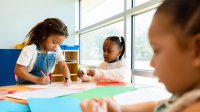Support Emotional Literacy With the Healing Hand Activity
Not all challenges can be solved, but an activity that helps students identify their support systems and coping strategies can boost their well-being.
How can I help my students thrive and reach their fullest potential? Can I help my students improve their mental health and behavior? These and related inquiries fill our minds as educators dedicated to supporting our students. Yet the answers are often elusive, especially in recent years, when critical factors such as trauma, inequity, and the challenges of virtual or hybrid teaching have filled our learning environments.
The effects of the pandemic have taken a toll on students and teachers alike, with anxiety, stress, and fear imbuing our personal lives and school settings. We wonder, what can we do about it? Are teachers really equipped to recognize students’ feelings and cope with unprecedented situations?
Across the United States, school districts are incorporating mindfulness and social and emotional learning (SEL) programming into their curricula. These programs focus on students’ mental well-being, but not all schools have access to them, and not all programs teach equitable strategies.
So what can elementary teachers do if their district does not incorporate these programs? For starters, infusing children’s literature that centers a breadth of attitudes, feelings, and mindsets into the curriculum can provide support when students are facing troubling situations within and outside of the classroom. After reading and discussing literature that facilitates considerations of emotion, children can then apply what they have learned by doing extension activities that support self-awareness.
Here’s one example that we have utilized with kindergarten and first-grade classes—and that could apply to learners through fourth grade.
Using Literature to Facilitate Discussions About Emotion
Adam Lehrhaupt’s children’s book There Was a Hole is a resource that can help students understand their feelings. The text focuses on self-awareness, self-management, and responsible decision-making—three tenets of social and emotional learning as defined by CASEL.
The main character, Lily, has a hole in her chest that cannot be filled. No amount of cake, museum visits, or soccer can fix the pain she feels. Lily meets a friend who teaches her how to make patches. The patches may not completely fix the pain, but they do make Lily feel better. They are metaphorical displays of healing; the act of crafting serves as a form of self-regulation, and the completed patches facilitate opportunities to make social connections and discover joy in shared areas of interest.
Lily’s journey positions students and teachers to have class discussions about difficult emotions, the power of friendship during challenging times, and constructive coping skills that can “patch” if not completely fix pain.
To further build upon students’ emotional literacy, teachers can follow reading and discussion with an extension activity, the Healing Hand, which focuses on finding the good, even in a bad situation.
The Healing Hand: An Extension Activity
For this activity, students can either trace their hand or use a hand template. In the middle of the outlined hand, invite students to write stressors and challenges (for younger students, or as a way to differentiate learning, students may dictate to a trusted adult—a teacher or school counselor—who acts as a scribe). Let them know they will have full control over who sees their completed diagrams.
On each finger, ask students to brainstorm ways to cope with their identified challenges, creating a visual representation of adaptation. Not every challenge, for example, has a solution, so the goal here is not to imply an easy fix in the face of stress but to encourage students to become aware of possible support systems and to foster a sense of agency amid trying circumstances.
To further reinforce the sense of a support system, you can welcome guidance counselors or other school support staff into the classroom to talk about coping strategies and resources that exist at school and to offer support to students whose challenges may raise concern. This is a great way to normalize help-seeking, familiarize students with caring adults in the building, and support students’ sharing.
After students have completed their diagrams, you can scaffold optional sharing by inviting students to choose whether they keep their hand diagrams to themselves, share confidentially with you or a counselor, or share with trusted peer(s) or the larger group.
Doing so facilitates reflection, and students are able to connect on a deeper level with their peers while developing their empathy skills. They can discuss similarities between their challenges and support systems. And those comfortable with having a wider audience might post their Healing Hands in a designated area, such as a calm-down corner, for visual reminders about identified coping strategies.
When displaying the hands, consider arranging them in a way that they are interconnected. This symbolizes the importance of relationships and support systems and shows students that they are never alone. If students are uncomfortable with their hands being displayed publicly, consider laminating them to keep in a desk, folder, or safe space so that the students can reflect privately during a challenging time.
Bridging Connection and Boosting Sense of Future
Students are facing many challenges—anxiety, worry, and fear among them—but they don’t always express these feelings verbally. The Healing Hand activity offers a way for students to share their worries and fears while identifying the support systems available in their lives.
Healing Hands can serve as visual reminders that there are always resources available in times of challenge. They can serve as a bridge for students who might benefit from building relationships with school counselors or other support staff. And by incorporating SEL activities into the classroom, teachers can help students learn how to build confidence and resilience for their future.
